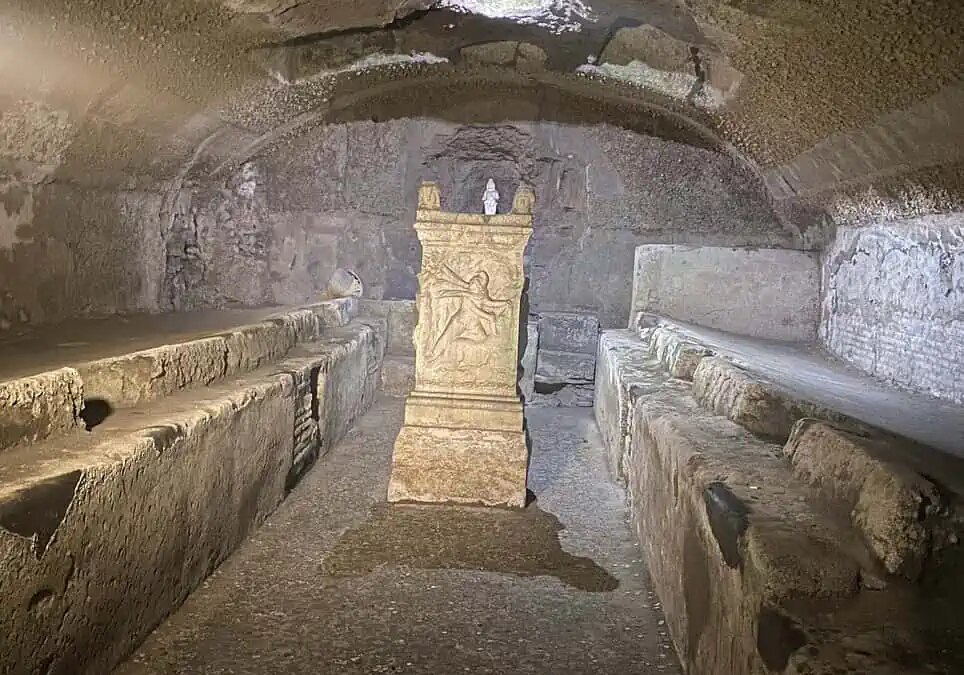Since I used to live in Rome, I have seen the main sights many times. The Colosseum, Vatican Museum, and Forum are amazing places I have seen repeatedly. But this time, my partner and I wanted to do something different.
“Do you want to explore underground Rome with me?” I asked. “Awww, yeah,” was his response.
We took the train to Rome from Puglia, found a simple lodging near Piazza Navona, and headed to the Vatican, where we signed up for an archaeological visit deep underneath the basilica. And so started our exploration of the underground sights in Rome.
Related read: Things to Do in Rome: Our Rome Activity Guide

Hidden Gems Underground Rome
Ready to explore underground Rome? Check out the below list of sites and tours.
Necropolis tour: St. Peter’s
For centuries, oral and written history claimed that the present basilica of St. Peter’s was built over the tomb of the apostle Peter, but many were skeptical of this claim. Finally, excavations began in the 1940s to find out what was there. The dig was challenging because archeologists and engineers had to make sure that they would not cause the collapse of the basilica above.
Nobody knew what would be found, but most archeologists believed that, after 2000 years, there would probably just be rocks and dirt.
To the surprise of many, the excavators announced that they had discovered a burial ground (aka a necropolis) dating back to the 4th century.
This discovery is the beginning of the Necropolis tour below St. Peter’s.
The dig continued, and archeologists uncovered even older burial areas.
Today, certified tour guides bring a small group of visitors below the basilica floor and then further down below the tombs of the popes to a cold and dark archeological area; walking on ancient streets, visitors pass ancient mausoleums and testaments of love to those who passed.
The tour is organized like a “whodunit,” as the guide and participants seek evidence for the location of the burial place of Peter.
I don’t want to give the end of the story, but the tour is one of the most amazing experiences that I have had in Rome.
Getting tickets can be challenging (Excavations office, Vatican/Ufficio Savi), but the effort is well worth it.
- You can book tickets online with Get Your Guide: Marvel at panoramic views of iconic landmarks like the Colosseum and Pantheon before descending into the Basilica to admire its impressive interior, adorned with colorful marble and intricate mosaics. Explore the historic grottoes, visit St. Peter’s Tomb, and conclude the tour in the majestic St. Peter’s Square.
The day after our Necropolis tour, we decided to visit Nero, whose home is near the Colosseum today.
Domus Aurea
History was changed when a 15th-century man descended through a hole on the Esquiline hill, candle in hand, and looked up. He didn’t know it yet, but he discovered Nero’s Golden House, the Domus Aurea, the dream of an emperor more known for his madness than his accomplishments.
A local archeologist leads visitors through the excavated rooms of the Domus, bringing the rooms and frescoes alive.
After exploring the first part of Nero’s house, we sat in a large ancient room, put on virtual reality headsets, and experienced the glory of this complex. It was a roller coaster ride of striking images of the gardens, buildings, and complex conceived by Nero.
When we walked into the circular room, which was probably used for feasting, I found the thought of Nero and his guests fascinating. Unpredictable and vengeful, an invitation to the emperor’s table was not what senators and aristocrats longed for; at such a meal, they were sometimes constrained to give up their wives and dignity, so they tried to avoid Nero’s invitation as much as possible.
As I stood in that circular room, with its oculus and waterfall, I wondered what Nero’s guests felt, standing where I was, as they wondered what his next move would be. Would he require one of the senator’s wives to have sex with him in the next room? Would he take offense at an offhand remark? Would he start singing for his guests for hours, expecting long, heartfelt applause?
There I stood, amid it all, almost hearing the thoughts and fears of those who stood on this spot.
- Book a tour of Aurea Domus with Get Your Guide: Explore the archaeological restoration of Nero’s Golden House, the Domus Aurea, with an expert guide and cutting-edge technology like VR Oculus and video narration. This innovative tour offers a guided exploration of the site, providing captivating visual glimpses into Emperor Nero’s opulent palace from 2,000 years ago.
Further down the street from the Colosseum is St. Clement’s, which felt like being transported to another world.

St. Clement’s
Exploring St. Clement’s captures the experience of going back in time. The Basilica of San Clemente is a multi-level time machine: there are two churches, one built over the other; the lower church was, in turn, built over Roman buildings of the 1st century.
Just stepping into the ground-level church brings one into the 12th century, with its incredible mosaic apse, ancient floor, and 6th-century marble chancel. Descending further, one enters the 4th-century church, with its stunning medieval frescoes dating from the 8th to the 11th century.
When one descends even further, one is embraced by the 1st century, with its Mithraic temple and across a narrow alleyway, a large public building, around whose foundations flow the lost waters of Rome.
It is difficult to describe the feelings I had as I sat on a stone seat outside the Mithraic temple, in the very place where ancient soldier worshipers would have sat before being admitted. What were they thinking? What were they feeling? What were they hoping for?
- Book this tour of San Clemente Underground and Basilica: Explore this remarkable site, delving into three underground levels that unveil over 2,000 years of history. Beneath the Basilica, a dazzling gold mosaic in the central nave was uncovered, revealing secrets hidden since 1860 when an Irish Dominican priest and archaeologist discovered the underground levels after a flood.

As I listened to the underground river rushing behind its stone walls, the mystery of St. Clement’s began to reveal itself. The layers of history demonstrate that humanity always seeks the meaning behind the everydayness of life, no matter what era.
The next day, we visited the Forum to tour the first emperor’s and his wife’s homes.
House of Augustus and Livia
The House of Augustus and the House of Livia are part of the imperial compound, which contains some of the best surviving examples of ancient Roman painting anywhere. Admiring the same artworks that Augustus himself gazed at two millennia ago is an incredible experience. The most impressive room is that identified as the emperor’s study on the upper floor. According to contemporary sources, Augustus would retreat here to think or study privately.
Standing inside the walls of Livia’s home, gazing at her garden frescoed walls, or into the intimate study of Augustus, where he planned and plotted the empire, I can’t help but feel connected with the real people behind an empire; these people had a dream of greatness and made it come true.
- Join this private tour of the House of Augustus and Livia: Embark on a journey to the heart of the Roman Empire, where you can explore the magnificent houses of Augustus and Livia. Visit the palaces of the emperors, revel in the views from the Palatine Hill, and discover some of Rome’s most exclusive and captivating ancient sites.
Exploring the archaeological findings under the streets of Rome reveals the city’s roots that many tourists miss. I am grateful we can discover other layers of this amazing city, even after living there for eight years.



Recent Comments